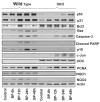Inactivation of the quinone oxidoreductases NQO1 and NQO2 strongly elevates the incidence and multiplicity of chemically induced skin tumors
- PMID: 20103645
- PMCID: PMC2943744
- DOI: 10.1158/0008-5472.CAN-09-2938
Inactivation of the quinone oxidoreductases NQO1 and NQO2 strongly elevates the incidence and multiplicity of chemically induced skin tumors
Retraction in
-
Retraction: Inactivation of the Quinone Oxidoreductases NQO1 and NQO2 Strongly Elevates the Incidence and Multiplicity of Chemically Induced Skin Tumors.Cancer Res. 2018 Nov 1;78(21):6345. doi: 10.1158/0008-5472.CAN-18-2453. Cancer Res. 2018. PMID: 30385611 Free PMC article. No abstract available.
Abstract
The cytosolic quinone oxidoreductases NQO1 and NQO2 protect cells against oxidative stress by detoxifying quinones and preventing redox cycling. In this study, we used double knockout (DKO) mice deficient for NQO1 and NQO2 to investigate the role of these antioxidative enzymes in a two-stage model of inflammatory skin carcinogenesis. In this model, tumors are caused by exposure to topical carcinogen dimethylbenz(a)anthracene or benzo(a)pyrene (BP) followed by twice weekly application of proinflammatory phorbol 12-myristate 13-acetate. On this classic chemical carcinogenesis protocol, DKO mice showed a significantly higher skin tumor frequency and multiplicity compared with control wild-type or single knockout mice. Analysis of skin from wild-type and DKO mice exposed to BP for 6, 12, or 24 hours revealed a relative delay in the activation of p53, p63, p19ARF, and apoptosis in DKO mice, consistent with a negative modifier role for NQO1/NQO2 in carcinogenesis. Our findings offer genetic evidence of the significance of quinone oxidoreductases NQO1 and NQO2 in limiting chemical skin carcinogenesis.
Figures






References
-
- International Agency for Research on Cancer (IARC) IARC Monographs on the Evaluation of Carcinogenic Risks of Chemicals to Humans-Polynuclear Aromatic Compounds. 33–91. Vol. 32. Lyon: International Agency for Research on Cancer Scientific Pub; 1983. pp. 211–24.
-
- Pugalendhi P, Manoharan S, Panjamurthy K, Balakrishnan S, Nirmal MR. Antigenotoxic effect of genistein against 7,12-dimethylbenz[a]anthracene induced genotoxicity in bone marrow cells of female Wistar rats. Pharmacol Rep. 2009;61:296–303. - PubMed
-
- Prince M, Campbell CT, Robertson TA, Wells AJ, Kleiner HE. Naturally occurring coumarins inhibit 7,12-dimethylbenz[a]anthracene DNA adduct formation in mouse mammary gland. Carcinogenesis. 2006;27:1204–13. - PubMed
-
- Housman TS, Feldman SR, Williford PM, et al. Skin cancer is among the most costly of all cancers to treat for the medicare population. J Am Acad Dermatol. 2003;48:425–9. - PubMed
-
- Ross D. Quinone reductases multitasking in the metabolic world. Drug Metab Rev. 2004;36:639–54. - PubMed
Publication types
MeSH terms
Substances
Grants and funding
LinkOut - more resources
Full Text Sources
Medical
Molecular Biology Databases
Research Materials
Miscellaneous

